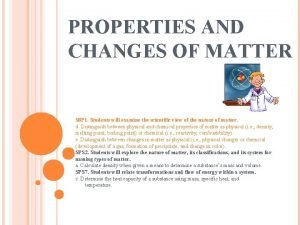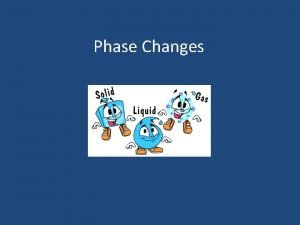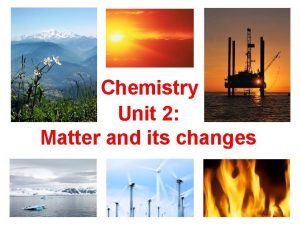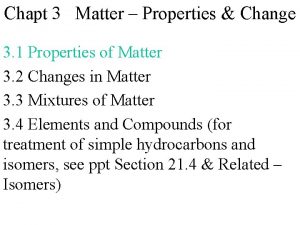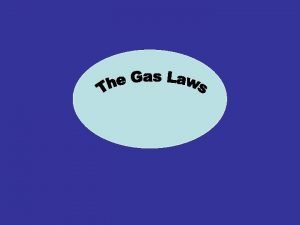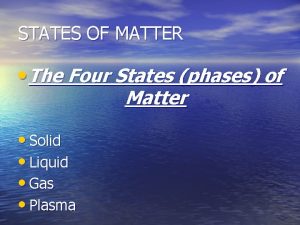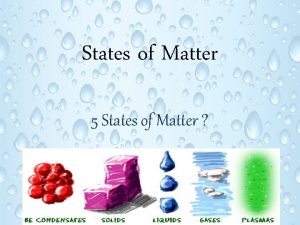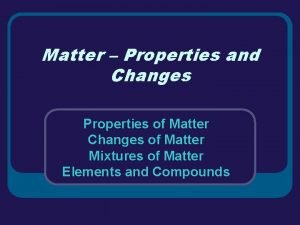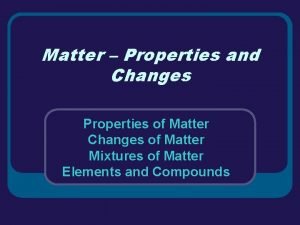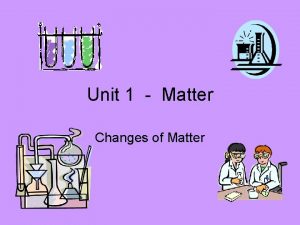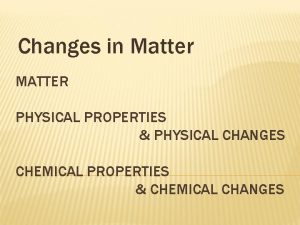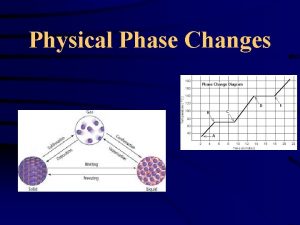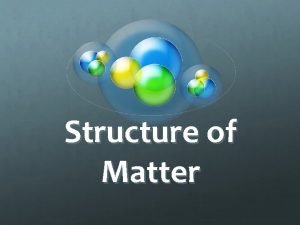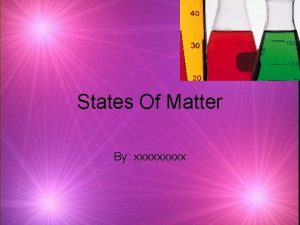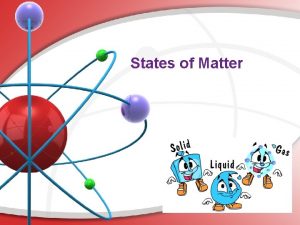States of Matter Changes of State States of

























- Slides: 25

States of Matter Changes of State

States of Matter Objectives Explain the relationship between equilibrium and changes of state Interpret phase diagrams Explain what is meant by equilibrium vapor pressure Describe the processes of boiling, freezing, melting, and sublimation

States of Matter Possible Changes of State

States of Matter Changes of State and Equilibrium A phase is any part of a system that has uniform composition and properties Condensation is the process by which a gas changes to a liquid A gas in contact with its liquid or solid phase is often called a vapor Equilibrium is a dynamic condition in which two opposing changes occur at equal rates in a closed system Eventually, in a closed system, the rate of condensation equals the rate of evaporation, and a state of equilibrium is established

States of Matter Liquid - Vapor Equilibrium System

States of Matter Equilibrium Vapor Pressure of a Liquid Vapor molecules in equilibrium with a liquid in a closed system exert a pressure proportional to the concentration of molecules in the vapor phase The pressure exerted by a vapor in equilibrium with its corresponding liquid at a given temperature is called the equilibrium vapor pressure of the liquid The equilibrium vapor pressure increases with increasing temperature Increasing the temperature of a liquid increases the average kinetic energy of the liquid’s molecules

States of Matter Measuring the Vapor Pressure of a Liquid

States of Matter Equilibrium Vapor Pressure of a Liquid Every liquid has a specific equilibrium vapor pressure at a given temperature All liquids have characteristic forces of attraction between their particles

States of Matter Equilibrium Vapor Pressure of a Liquid Volatile liquids are liquids that evaporate readily They have relatively weak forces of attraction between their particles example: ether

States of Matter Equilibrium Vapor Pressure of a Liquid Nonvolatile liquids do not evaporate readily They have relatively strong attractive forces between their particles example: molten ionic compounds

States of Matter Boiling is the conversion of a liquid to a vapor within the liquid as well as at its surface The boiling point of a liquid is the temperature at which the equilibrium vapor pressure of the liquid equals the atmospheric pressure. The lower the atmospheric pressure is, the lower the boiling point is At the boiling point, all of the energy absorbed is used to evaporate the liquid, and the temperature remains constant as long as the pressure does not change If the pressure above the liquid being heated is increased, the temperature of the liquid will rise until the vapor pressure equals the new pressure and the liquid boils once again

States of Matter Boiling The normal boiling point of a liquid is the boiling point at normal atmospheric pressure (1 atm, 760 torr, or 101. 3 k. Pa) The normal boiling point of water is exactly 100°C

States of Matter Energy and Boiling Energy must be added continuously in order to keep a liquid boiling The temperature at the boiling point remains constant despite the continuous addition of energy The added energy is used to overcome the attractive forces between molecules of the liquid during the liquid-to-gas change and is stored in the vapor as potential energy

States of Matter Molar Enthalpy of Vaporization The amount of energy as heat that is needed to vaporize one mole of liquid at the liquid’s boiling point at constant pressure is called the liquid’s molar enthalpy of vaporization, ∆Hv The magnitude of the molar enthalpy of vaporization is a measure of the attraction between particles of the liquid The stronger this attraction is, the higher molar enthalpy of vaporization

States of Matter Molar Enthalpy of Vaporization Each liquid has a characteristic molar enthalpy of vaporization

States of Matter Freezing and Melting The physical change of a liquid to a solid is called freezing Freezing involves a loss of energy in the form of heat by the liquid solid + energy In the case of a pure crystalline substance, this change occurs at constant temperature

States of Matter Freezing and Melting The normal freezing point is the temperature at which the solid and liquid are in equilibrium at 1 atm (760 torr, or 101. 3 k. Pa) pressure At the freezing point, particles of the liquid and the solid have the same average kinetic energy Melting, the reverse of freezing, also occurs at constant temperature solid + energy liquid

States of Matter Freezing and Melting At equilibrium, melting and freezing proceed at equal rates. solid + energy liquid At normal atmospheric pressure, the temperature of a system containing ice and liquid water will remain at 0. °C as long as both ice and water are present. Only after all the ice has melted will the addition of energy increase the temperature of the system

States of Matter Molar Enthalpy of Fusion The amount of energy as heat required to melt one mole of solid at the solid’s melting point is the solid’s molar enthalpy of fusion, ∆Hf The magnitude of the molar enthalpy of fusion depends on the attraction between the solid particles

States of Matter Sublimation and Deposition At sufficiently low temperature and pressure conditions, a liquid cannot exist Under such conditions, a solid substance exists in equilibrium with its vapor instead of its liquid solid + energy vapor The change of state from a solid directly to a gas is known as sublimation The reverse process is called deposition, the change of state from a gas directly to a solid

States of Matter Phase Diagrams A phase diagram is a graph of pressure versus temperature that shows the conditions under which the phases of a substance exist The triple point of a substance indicates the temperature and pressure conditions at which the solid, liquid, and vapor of the substance can coexist at equilibrium. The critical point of a substance indicates the critical temperature and critical pressure

States of Matter Phase Diagrams The critical temperature (tc) is the temperature above which the substance cannot exist in the liquid state. Above this temperature, water cannot be liquefied, no matter how much pressure is applied The critical pressure (Pc) is the lowest pressure at which the substance can exist as a liquid at the critical temperature

States of Matter Phase Diagram H 2 O

States of Matter Phase Diagram CO 2

States of Matter Changes of State
 Change of state of matter
Change of state of matter Changes in latitudes, changes in attitudes meaning
Changes in latitudes, changes in attitudes meaning Example of chemical changes
Example of chemical changes Properties and changes of matter worksheet
Properties and changes of matter worksheet Endothermic reaction characteristics
Endothermic reaction characteristics 5 phases of matter
5 phases of matter Definition of substance
Definition of substance Matter-properties and changes answer key
Matter-properties and changes answer key Two types of changes
Two types of changes Which is a “big idea” for matter and change?
Which is a “big idea” for matter and change? True or false: chemical and physical changes alter matter.
True or false: chemical and physical changes alter matter. Phase changes of matter
Phase changes of matter Phase change descriptions
Phase change descriptions Phase change concept map
Phase change concept map Classification of matter section 1 composition of matter
Classification of matter section 1 composition of matter What is the difference between gray and grey
What is the difference between gray and grey Composition of matter section 1
Composition of matter section 1 Chapter 2 section 1 classifying matter answer key
Chapter 2 section 1 classifying matter answer key Arbor vitae
Arbor vitae Section 1 composition of matter chapter 15 answer key
Section 1 composition of matter chapter 15 answer key Gray matter and white matter
Gray matter and white matter Telencephalon
Telencephalon Flow of energy vs flow of matter
Flow of energy vs flow of matter Lesson 6 changes of state answer key
Lesson 6 changes of state answer key Phases of matter foldable
Phases of matter foldable Four states of matter
Four states of matter



